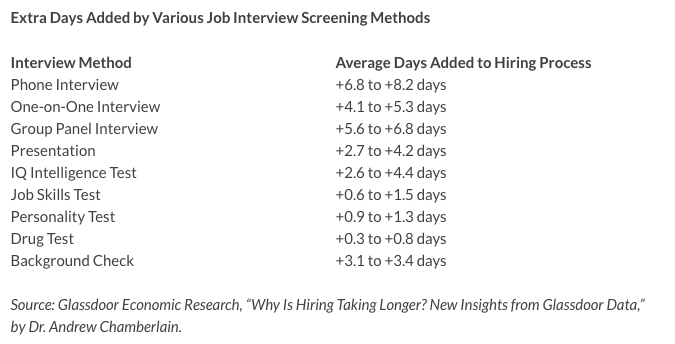How To Reduce Your Time-to-Hire
Have you recently examined how long it takes for you to hire a candidate? The time-to-hire metric is essential to understanding the efficiency of your hiring process. First off, let’s define time-to-hire.
“It is the duration of time that elapses between the initial contact with a job candidate up until the time that they accept the offer of employment.”
I’ll note that time-to-hire is NOT the same as time-to-fill. Time-to-hire tracks how fast you move as soon as you’ve made contact with the right potential candidate(s). The time-to-fill metric tracks the number of days between the publication of a job and getting an offer accepted.
The average time-to-hire has been steadily climbing since 2009. By country, in 2014, it ranged from 22.1 days in Canada to 31.9 days in France (Glassdoor Economic Research).
Now, this is just an average, it varies greatly across industries. It’s important to note though, that time-to-hire is steadily climbing and we should examine the impacts and why this is happening.
What is the impact of a longer time-to-hire?
The implications of a lengthy time-to-hire can be quite vast, especially on a national level. The most recent statistical data highlights that there are currently 5.7 million job openings in the United States. It’s clear there are jobs out there, but there is a skills gap and companies are finding it difficult to commit to hiring people. Typically, a longer period between employers advertising a job and having an offer accepted (time-to-fill) is a sign of a healthy economy. However, there are over 7.2 million Americans currently unemployed.
To summarize, the impact includes:
- Lost wages for job seekers.
- Longer unemployment periods in the economy.
- Productivity challenges in the workplace.
- Wasted time and money.
- Negative employer brand image and candidate experience.
Why is time-to-hire increasing?
Time-to-hire is increasing due to a variety of factors. One of the biggest reasons is more careful screening methods being used. Companies are utilizing additional screenings such as panel interviews, background checks, skills test, presentations, etc. Each of these adds significant hiring times. For example, a panel interview adds one full week to the screening time.
 Source: Glassdoor Economic Research
Source: Glassdoor Economic ResearchNow, companies are taking more time to screen candidates for a reason. More careful screening could lead to better matches with the demand for high-skilled jobs on the rise.
But, if you take too much time, you risk losing the interest of a candidate since we are in a highly competitive recruiting market. In fact, according to the Society for Human Resource Management (SHRM), forty-nine percent (49%) of HR pros cite competition from other employers as a big challenge (Source: HR Bartender).
How can I reduce my time-to-hire?
With recruiting becoming more of a challenge, employers are looking for more creative ways to improve their hiring process and hence reduce their time-to-hire. One way to do it is by adopting a more collaborative hiring process.
Working together as a team, especially the Recruiter and Hiring Manager, can keep recruitment efficient with costs contained. Here’s what you can do:
- Collaborative hiring starts with the job posting. Work together and get consensus on what is required for the job. Doing this will shorten your time-to-hire since there will be minimal discrepancies on what’s required for the role.
- Communication is key. When candidates apply, they expect a quick response. Have a process in place to ensure you respond promptly to every candidate. Doing this improves your employer brand and the overall candidate experience – keeping them from looking elsewhere upon first contact.
- Create a interdepartmental agreement to make quicker and more informed decisions on the candidates. An Applicant Tracking System allows you to communicate with your team quickly via commenting, tagging and forwarding full profiles of your candidates via email.
- Conduct group interviews to get the key decisions makers involved in the process. It minimizes the number of interviews you need to conduct with each candidate. Not sure which questions to ask for your interviews. Here’s a toolkit to help you out.
- Report and analyze your workflows to determine how long it is taking to set up interviews, schedule testing, get background checks completed, etc. Determine how many days it takes for each stage and examine more creative ways to trim back the days.
Related: Effective Interview Techniques for Employers
Conclusion
I hope you’ve learned a ton about time-to-hire. What it means, it’s impact and what you can do to reduce it. Above all, we all want to make great hires. I honestly believe that working together can speed up your time-to-hire and make for an overall better hiring experience for both you and the job seeker.
{{cta(‘5d4ddac1-9ac7-47fc-b861-b1c8f01da2c8’)}}
